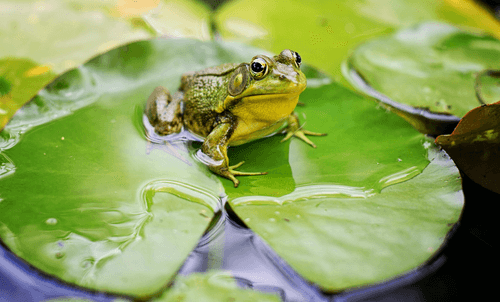A wildlife pond essentially is a pond planted with native plants in order to attract native animals. If the purpose of your garden pond is to attract wildlife (as opposed to an ornamental pond or using it to stock fish), then you need to start by constructing your pond in such a way that wildlife can survive in and around your pond. A pond constructed with shelves of varying water levels or at least one side of the pond having a gentle slope, will allow creatures to get in and out of the pond with ease.
To attract and keep a wide variety of wildlife visiting your pond, you also need to create a safe haven for them to live in. To achieve this you need to plant a diverse range of native plants in your pond and lots of leafy plants around the edge of your pond. Lay a pile of logs, branches or rocks in amongst the leafy plants to the edge of your pond. This will create a safe haven for frogs and toads. Also ensure that you create corridors amongst the vegetation for them to move about with ease and in safety. Frogs naturally find new ponds quickly so adapt your pond to offer the best conditions for them to live and breed in.
Another amphibian likely to visit your pond, are Newts, which will arrive in early spring. They leave the pond in summer and will hide under logs and rocks on the waters edge. Newt tadpoles breathe under water until they are ready to leave the pond in late summer.
Your pond will also become home to many insects. From mid summer to the end of September you may spot dragonflies buzzing around hunting other insects. Dragonfly nymphs spend up to 5 years in the pond before they hatch into an adult fly. Other insects include the Pondskater, which skims across the water looking for insects that have fallen into the water. There are also beetles are various types, which will inhabit your pond.
Hedgehogs are also attracted to ponds and may be seen at dusk as they go out in search of snails, slugs and earthworms.
Small birds, such as greenfinches and blackbirds will also use a pond, which has gently sloping sides. They will come to the pond to drink and bath. Herons may even visit your pond to feed on any adult frogs that may have become complacent about their own safety. Dense planting on the edge of a pond and rocks in and around a pond will create a safe haven for frogs making it more of a challenge for herons to come to your pond in search of food.
Your pond may even be visited at night by local foxes and badges.
Try not to disturb the water in your pond or around the edges from late autumn to early spring so that any hibernating creates are not woken and frightened away. Any cleaning or mending of your pond liner should be done in early autumn.






